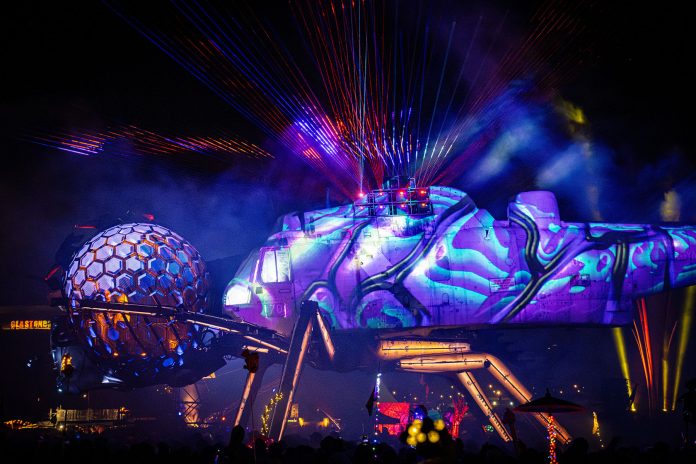
An Avolites’ D9 console and AI Qgen media servers running Synergy protocol were at the heart of lighting and video control for Arcadia Spectacular’s Dragonfly at Glastonbury Festival 2024.
Originated and designed by Creative Director, Pip Rush and Technical Director, Bert Cole, the 30m-long, 8.5m-high biomechanical Dragonfly is built from an ex Royal Navy Sea King helicopter and was surrounded by a 50,000-capacity evolved geometric ‘energy field’ at the festival.
The sculpture ‘awakened’ every night of Glasto at 23:30pm, presenting Warraloo – a breathtaking nine-minute show developed by Arcadia in collaboration with the Wadjuk Noongar nation of Western Australia and based on the Dragonfly’s pupation cycle.
The Dragonfly head is covered with over 200 custom hexagonal and pentagonal LED screens, the legs were pixel mapped, the body was projection mapped, and over 200 lighting and LED pixel fixtures were rigged on the construction and dotted around the Arcadia arena, all vital elements of the production lighting scheme created by Dave Cohen of MIRRAD, who was also responsible for designing and supplying the full lighting and visual control system and all the related integration.
In addition to the Dragonfly, four sets of scenic bull-rush podiums, also created from recycled scrap metal, circled the space, two of them doubling as performance areas for elements of the timecoded show. Six 11m-high lighting towers were positioned around the outside of the arena, rigged with – among other lighting fixtures – six of Robe’s new searchlight style laser-lightsource iBOLTS.
Cohen explained that lighting for the event was 95% operated live or busked – only the Arcadia shows were timecoded, so with operating sessions of five hours or more, the Avolites D9-330 was his desk of choice for this style of operation. “It is absolutely the best option” to combine busking and cue stacking as well as facilitating the seamless live operation of lighting and video.
Cohen and MIRRAD’s Sam Werrett operated Arcadia’s lighting for all artists across the Glastonbury weekend working in close conjunction with the live visuals team featuring Australian artists, Peter Walker and Brad Hammond, who used Touch Designer and Unity to bake the visuals on to a UV map, which was mixed by Joe Crossley from Astralprojekt using a MIDI controller.
Werrett harnessed D9 features like Timeline, Timecoded Cue Lists, Pixel Mapper, among others. Align made it straightforward to copy all the positional and other fixture information from – in this case – one tower and apply it to another, which saved time when dealing the parts of the lighting rig hidden from the FOH position which was side-on to the Dragonfly – rather than having to adjust every light.
The D9 console’s rotary playback faders were utilised to execute some on-the-fly safety parameters like dimming strobes or lighting that might inadvertently get in performer faces during the live shows.
Using Avolites Synergy to unite the worlds of video and lighting control enabled Cohen and Werrett to see the NDI previews of the visuals being created and instantly match or contrast colour-wise with lighting and crossfade between outputting lighting and video feeds. “Avo’s history is in live operation and the D9’s versatility meant we could keep the show fresh and invigorated with new looks and combinations even after a 5-hour plus operating shift,” Werrett remarked.
All the timecoded parts were pre-visualised in WYSIWYG – using a model of the helicopter – and fine-tuned on site, and they also had a WYG set up on site, networked to the FOH which enabled video and lighting and video to be processed in the same previsualisation environment.
The two D9 consoles – live and backup – were run in multi-user mode, allowing looks, combinations and effects to be prepared and trialled on one and then output on the other as the evening progressed. Coordinating the AI media server side of the control for MIRRAD was Arran Rothwell-Eyre, one of the original team behind AI, and Greg Haynes from Avo provided additional technical support. The LED screen design and installation for the head of the helicopter was created by Ben Vaughan and Video Illusions.
Arcadia Technical Production Manager, Katie Davies, commented: “It’s great to work with a team who just really get what we are trying to do, and with whom we can build on the knowledge and experience of previous years and stage designs.”





